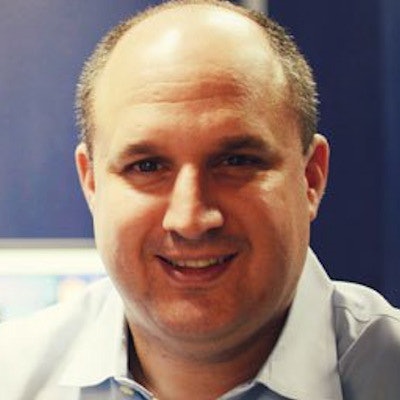
The lights go down as the radiology attending in the front of the classroom prepares the computer for a case presentation. A switch is flicked on and a black-and-white PowerPoint case suddenly begins to shine brightly on the screen in front of you.
The radiologist glances about the room looking to see who would be the best fit for this next case. You begin to sweat and fidget with your hands, praying you will not be called on next. Suddenly the attending's glance remains fixed upon you. He says, "Tell me about this patient with a two-year history of cough!" You become flustered and aren't sure what to say.
The scenario above is a common everyday occurrence in radiology residencies across the country. However, over the past few years, I have noticed an overall decrease in proficiency in the way that residents present each radiological case. The art has been partially lost.
 Dr. Barry Julius of RadsResident.com.
Dr. Barry Julius of RadsResident.com.Some of it may be related to poor teaching on our part. Some of it may be related to decreasing time allotted to teaching. Some of it may be related to the emphasis of the new board examination system. And, perhaps, some of it may be related to changes in newer radiology resident class culture.
In whatever case, it's a shame.
Taking cases orally is a crucial step to becoming a well-rounded radiologist. You need to be able to relate to your colleagues important information about the images in a timely, logical manner, no matter what you're looking at. If you want to look like a star, you need to have this process down cold.
So, in order to enable you to have the tools to get through a radiological case, I'm going to go through the basics, including determining the kind of study, presenting descriptive findings, coming up with a differential diagnosis, and, ultimately, determining proper management of the patient.
What the $#&@! am I looking at?
Whenever you are introduced to a new case, the first thing you need to do is determine what you are looking at. Take your time and think about what kind of images you are shown. Many times, the case discussion is lost before it even begins because the correct study is never identified. Is it an ultrasound, CT scan, MRI, x-ray, or nuclear medicine study? Is the examination performed with or without contrast? During what phase?
For nuclear medicine studies in particular, if you can identify what the study is prior to beginning to go through the rest of the case, 80% of the heavy lifting has already been done. You have already isolated the differential diagnosis if you can identify the radiopharmaceutical. So, if you are not sure, you should start describing the physiological distribution of activity that is present to help with identification. Often the act of describing the distribution helps the resident to understand the type of study.
Also, scan the images for any identifying information. If it is an ultrasound, it will often tell you which organ you are looking at. I have found it can be difficult to tell the testes, ovaries, and kidneys apart on a single image if it is not labeled. Usually, these studies are labeled so you will be able to differentiate among the options.
Finally, make sure to look at the top of the film to see if you can find the patient's age and sex. This can also further help you to hone in on the correct differential diagnosis.
Describing the findings
It is this part of the oral case where the newer residents fall short compared to residents who have studied to take the oral boards. Residents have a tendency to stop very quickly at the description part of the puzzle and then enter rapidly into a differential diagnosis. A poor quick description often leads to a poor differential diagnosis. Again, you need to take your time to describe all the salient points.
So, what should be included in this part of the case? Always make sure to describe the location, size, intensity (if nuclear medicine), shape, density, and borders. Describe its effect on adjacent structures. Make sure to use buzzwords if available.
If it's an angry-looking mass on a CT scan that looks like a star, you may want to use the words "spiculated" or "stellate." If it's a lesion with enhancing rim nodularity that fills in from the edge to the center, use the terms "peripheral nodular enhancement with centripetal filling." These buzzwords connote certain types of differentials in the minds of the radiologist listeners that provide information on the type of disease entity even prior to going through a differential diagnosis.
Finally, don't get "happy eye syndrome." Look for other findings that may support or refute your differential diagnosis. I can't tell you how many times a resident will stare at one section of the film only to forget to look at the rest of the images or the rest of the film, and lose the forest for the trees.
Concise, relevant differential diagnoses
The difference between a novice and a more seasoned resident is stark when it comes to giving a concise and relevant differential diagnosis. Novices will either have no idea what to say or will continue to drone on about multiple different possibilities for the final diagnosis. They do not even differentiate between the zebra and the most common diagnosis.
Again, take your time before speaking. Prior to even starting this process, in your own mind, you should be going through broad categories of what the differential diagnosis should be. Is it neoplasm, infection, inflammation, iatrogenic, congenital, etc.? Then, when you have come up mentally with some reasonable possibilities, make sure to talk about no more than three etiologies of what are the most likely diagnoses.
Start with the most likely and then go down in order to the least likely. This process will allow you to speak logically, as well as show that you have really thought about the differential in an analytical manner.
What's next for the patient?
There are really three options for the further management of the case after you have completed the basics of determining the findings and differential diagnosis:
- No further workup is needed and a final diagnosis has been established. One example would be an adrenal nodule with a Hounsfield Unit of 2. This finding would be consistent with an adrenal adenoma. End of story. No further workup needed.
- Alternatively, it may be imperative that another step be further worked up immediately. For instance, if you need to determine the matrix of an aggressive osseous lesion on a musculoskeletal MRI without a final diagnosis, make sure to recommend a plain film. Otherwise, the final disposition of the patient may never be determined.
- Lastly, there may be a lesion that has low clinical significance but needs to be followed over time. In this category would be the small lung nodule or the nonaggressive indeterminate liver lesion.
You can almost always categorize your case into one of these three groups. And it will show that you really thought about the ramifications of the imaging upon the clinical picture of the patient.
Final thoughts: Taking oral cases should be fun!
Taking imaging cases orally should not be a difficult or embarrassing process. In fact, it should become something that you look forward to in order to build your confidence and make you into a better radiologist. It is a summation of the most important ingredients needed to make an excellent radiologist: the ability to make the findings, synthesize the data, come up with an outcome, and communicate the results to the clinician.
Unfortunately, at many programs you are just expected to know how to take a case without having been taught the process. If that is the situation, at least now you have a framework of the basic fundamentals of how to take a case.
Just like anything else, being adept at taking cases orally is simply a matter of practice and knowing the process. Once you have the process down and the base knowledge, it is much easier to build upon your abilities and become better over time. You, too, can become a star at taking cases!
Dr. Barry Julius, founder and chief editor of RadsResident.com, has been an associate radiology residency director at Saint Barnabas Medical Center since 2009. RadsResident.com is designed to be a credible, reliable, and informative site dedicated to radiology residents, students, program directors, and physicians interested in other radiology residency topics, with an emphasis on day-to-day residency information that is not covered on most educational sites. Topics include surviving a radiology residency, residency learning materials/books, financial tips, and jobs.
The comments and observations expressed herein are those of the author and do not necessarily reflect the opinions of AuntMinnie.com.



















